Introduction
By 2025, the landscape of renewable energy will continue to evolve, with innovations enhancing efficiency, scalability, and reliability. Renewable energy storage is advancing to address intermittency issues, while AI integration is optimizing grid management and energy forecasting. Additionally, trends such as expanding solar production and scaling wind energy systems are helping to transition towards cleaner energy.
Emerging technologies like green hydrogen and alternative renewable energy sources are also diversifying the energy mix to reduce reliance on traditional fuels. Furthermore, IoT integration and microgrids are improving energy distribution and resilience. Meanwhile, blockchain integration is enhancing transparency in energy trading.
Top 10 Global Renewable Energy Trends for 2025:
1. Renewable Energy Storage
2. Wind Energy Systems
3. AI Integration
4. Scaling Solar Production
5. Alternative Renewable Energy
6. Green Hydrogen
7. IoT Integration
8. Microgrids
9. Blockchain Integration
10. Grid Integration

1. Renewable Energy Storage
By 2029, the renewable energy storage market is expected to reach $48.186 billion, with a compound annual growth rate (CAGR) of 29.9%. This growth is driven by the adoption of battery storage, grid resilience technologies, and large-scale renewable energy integration.
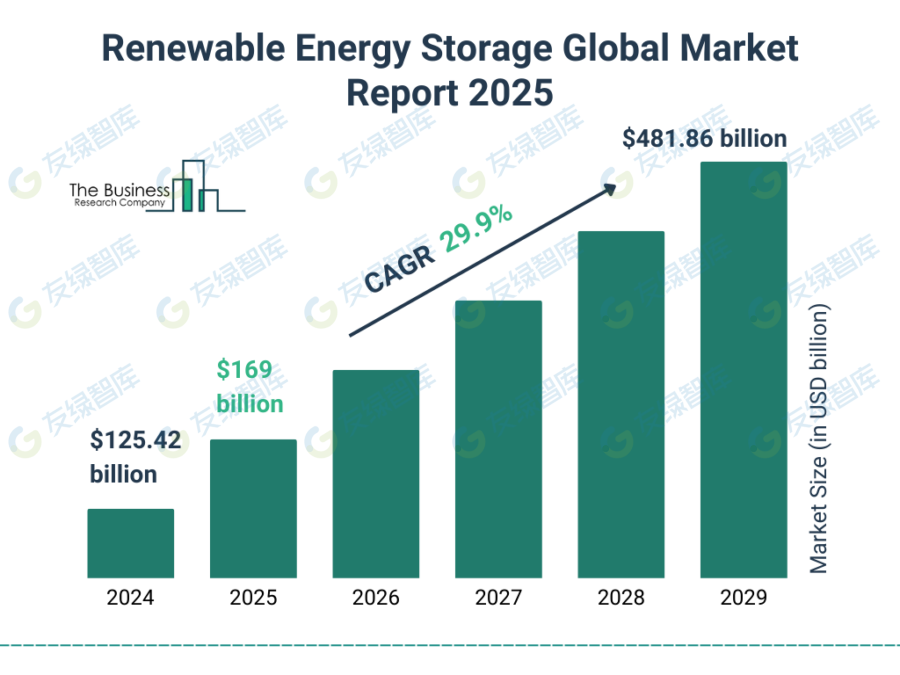
In the third quarter of 2024, investments in large renewable energy generation projects exceeded $3.3 billion, reflecting the momentum of global clean energy storage.
Storage plays a critical role in stabilizing the grid, addressing the intermittency of renewable energy, and supporting solar capacity expansion through 2033. As utilities focus on long-duration storage solutions, technologies like compressed air energy storage (CAES) and superconducting magnetic energy storage (SMES) are gaining attention.
Modern CAES systems enhance efficiency by using isothermal compression, reducing energy loss and supporting large-scale storage. This approach benefits grid stability and lowers costs.
Meanwhile, SMES technology, supported by advancements in superconducting materials, offers high efficiency and near-instantaneous response times. Despite higher costs, SMES is well-suited for grid stabilization and critical backup applications.
Otoro Energy manufactures flow battery systems.
The U.S.-based startup Otoro Energy has developed a metal-chelated liquid electrolyte for flow batteries. This electrolyte works by circulating two charged liquids through an electrochemical cell to store and release energy. It is free of precious metals and vanadium, supporting scalability and cost-effectiveness.
The electrolyte also features non-flammable, non-corrosive, non-toxic, and pH-neutral characteristics, enhancing safety. It provides reliable performance, high battery voltage, and long cycle life. Otoro Energy strengthens renewable energy integration and enhances grid stability through its scalable storage solutions.
The Heat Vault Company advances underground storage.
The U.K.-based startup The Heat Vault Company has built an underground storage system that utilizes naturally occurring rocks to store renewable energy as heat. The system consists of multiple deep wells, some for heat input and others for extraction. It can store energy collected during off-peak or low-demand seasons for days to decades.
The modular design allows for flexible construction, ranging from small installations to gigawatt-hour or terawatt-hour capacities. This long-duration storage solution addresses the intermittency of renewable energy, improving solar efficiency and supporting the adoption of renewables.
2. Wind Energy Systems
By mid-2024, global installed wind power capacity is expected to reach 1,097 GW, with an increase of 123 GW from July 2023 to June 2024. This is an increase from the previous period’s 100 GW growth. Wind power currently accounts for over 10% of global electricity generation.
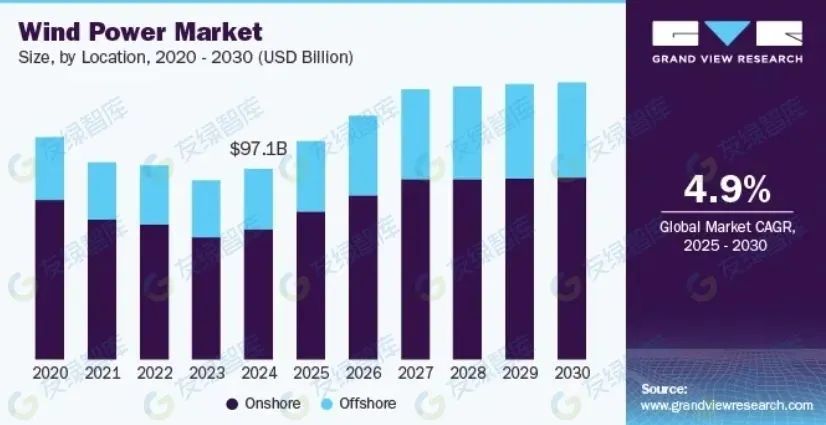
By 2024, the global wind power market is valued at $97.05 billion, with an expected CAGR of 4.9% from 2025 to 2030.
In Europe, offshore wind power capacity is expected to double by 2025, with the U.K., Germany, and Denmark leading the way. Significant progress is anticipated for offshore wind projects on the U.S. East Coast and in the Gulf of Mexico.
Government initiatives are further accelerating the expansion of offshore wind. The Indian Union Cabinet has approved a feasibility gap funding (VGF) plan worth ₹74.53 billion (~$893.34 million) to support offshore wind development.
Additionally, wind-solar hybrid systems are enhancing grid stability and optimizing the use of renewables. Robotic inspection systems are improving maintenance efficiency and reducing downtime.
Moreover, recyclable wind turbines are addressing sustainability issues, while AI is optimizing wind farm operations and predictive maintenance.
Windex Energy manufactures modular wind turbines.
The Slovenian startup Windex Energy designs modular wind energy devices for hilly terrain. These units are placed on hills where space constraints or transportation challenges prevent the installation of traditional wind turbines, thus utilizing optimal wind conditions.
This startup’s wind energy devices are bird-safe, with a lifespan of 60 years achieved through durable design principles. They are also recyclable, made of metal, and use additional anchoring to withstand extreme wind speeds.
3. AI Integration
By 2031, the AI market in renewable energy is expected to reach $3.2 billion, with a CAGR of 21.1% from 2024 to 2031.
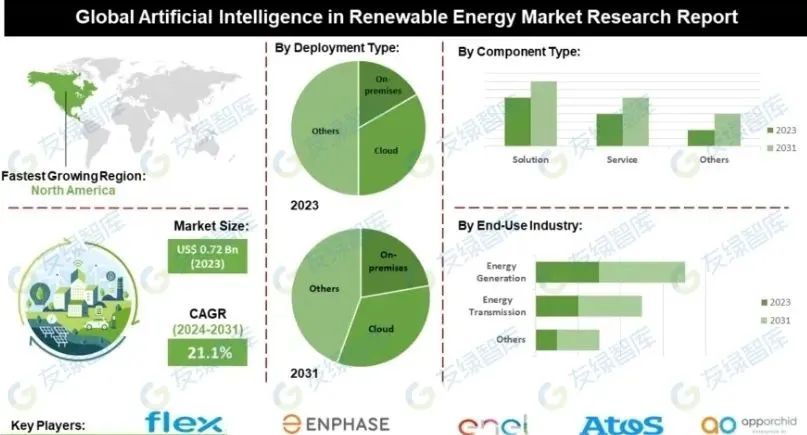
AI integration in renewable energy systems can enhance efficiency, reduce costs, and improve grid stability, accelerating its adoption across the industry.
AI-driven performance optimization is showing measurable results. The collaboration between Google and DeepMind demonstrates that AI has increased solar efficiency by approximately 20% through optimizing panel orientation and intelligent sunlight tracking.
Similarly, AI-supported predictive maintenance systems can reduce downtime by up to 70% by detecting early signs of equipment wear and failure. These systems enable renewable energy operators to save on operational costs.
AI also streamlines the development of new clean energy projects. According to the U.S. Department of Energy (DOE), AI has shortened development timelines by about 20%, potentially saving billions by 2050.
Furthermore, India’s National Power Plan aims to achieve 500 GW of renewable energy capacity by 2030, relying on AI for grid monitoring and storage management. In the U.S., the DOE is funding AI-based projects through laboratories like the Pacific Northwest National Laboratory to focus on grid optimization and renewable energy integration.
Additionally, AI applications in renewable energy span the entire value chain, from design to operation. AI-driven tools improve renewable energy forecasting, grid stability, and energy trading platforms.
In solar deployment, AI-driven robotic systems are now installing large-scale solar arrays in desert environments. These systems allow for cost-effective scaling of solar capacity to power data centers and industrial facilities.
Ravenwits advances renewable energy forecasting.
The Spanish startup Ravenwits has developed machine learning solutions for renewable energy forecasting. It uses deep learning models to analyze large datasets and identify patterns that improve energy output predictions. The models are optimized using methods such as linear models, decision trees, convolutional neural networks, transformer architectures, and graph neural networks to ensure each solution meets specific requirements.
This startup operates on an AWS-based platform to provide scalable and reliable forecasters integrated with existing infrastructure. Ravenwits enables energy companies to optimize production, improve financial outcomes, and manage resources more effectively.
tranXenergy implements AI-driven renewable energy management.
The Malaysian startup tranXenergy has built an AI-driven energy storage management system (ESMS) that optimizes energy consumption and generation. The ESMS uses predictive analytics to forecast daily solar generation and power consumption by analyzing historical data, weather patterns, and real-time energy usage.
Based on these forecasts, it schedules the charging and discharging of storage systems to ensure efficient energy distribution. The system continuously adapts to changing conditions, balancing energy production, consumption, and storage through real-time control. Its algorithms enhance return on investment and create new revenue opportunities by predicting and managing the flexible capacity of various storage devices, thereby increasing the value of storage.
4. Scaling Solar Production
By 2030, the global solar market is expected to reach $215.9 billion, with a CAGR of 1.5% from 2023 to 2030.
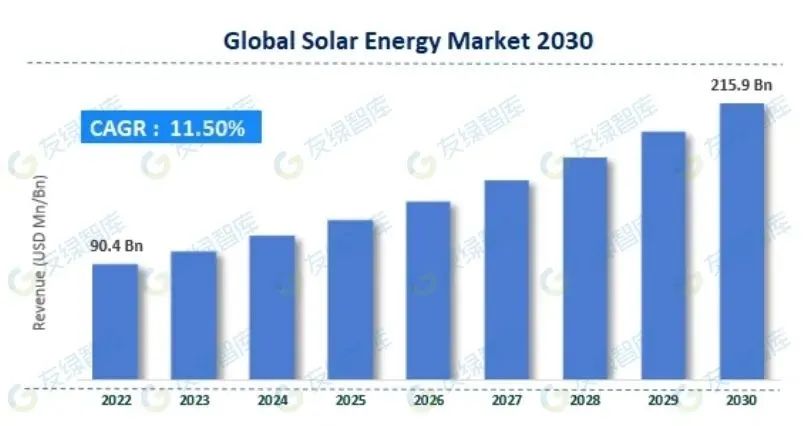
By 2024, investments in solar photovoltaics (PV) will exceed $500 billion, surpassing the total investment in all other power generation sources.
It is estimated that by 2024, the global new solar installed capacity will be 593 GW, a 29% increase compared to the installed capacity in 2023. The International Energy Agency (IEA) predicts that by 2030, new solar installed capacity will exceed 4,000 GW, accounting for 80% of the global renewable energy growth during that period.
In the U.S., utility-scale solar is rapidly growing. Its share of generation is expected to rise from 5% in 2024 to 7% in 2025 and 8% in 2026. This means that from 2024 to 2026, U.S. solar generation capacity will increase by 45%.
Moreover, efficient solar panel technologies play a crucial role in increasing generation and reducing costs. Perovskite solar cells, with potential efficiency levels exceeding 30%, are becoming a key advancement, especially when combined with traditional silicon panels to create tandem solar cells.
Additionally, bifacial solar panels, which capture sunlight from both sides, can increase generation by up to 30%, making them suitable for large solar power plants.
Furthermore, tunnel oxide passivated contact (TOPCon) technology achieves efficiencies of up to 25.9%, minimizing recombination losses and enhancing overall performance.
Newera Renewables builds grid-connected solar rooftop systems.
The Indian startup Newera Renewables offers customized solar solutions and fixed kits based on different customer needs. This startup designs tailored systems by analyzing energy usage, property layout, and financial constraints to develop suitable solar installations.
This startup’s 3 kW solar system meets the needs of small to medium households consuming up to 450 units per month. The 4 kW system is suitable for medium-sized homes, shops, and small offices with monthly usage of up to 600 units. Additionally, the 5 kW system serves small villas and workplaces with a capacity of up to 750 units, while the 6 kW system supports medium to large households consuming up to 900 units per month.
Moreover, larger setups include a 7 kW system for medium offices and villas (consuming 1,050 units), an 8 kW system for duplex homes (using 1,200 units), and a 9 kW system for large duplex homes and offices (using up to 1,350 units). Finally, the 10 kW system targets villas and bungalows consuming up to 1,500 units and allows for future expansion.
Sun Ice Energy manufactures solar thermal storage.
The Singapore startup Sun Ice Energy has developed a patented phase change material (PCM) technology that captures solar energy for sustainable cooling solutions. The system uses PCM (a material that absorbs and releases energy during phase changes) to store thermal energy. It combines PCM containers with rooftop solar panels to maintain the required temperature in applications like ice rinks and cold storage, even without sunlight.
This startup’s two-channel cooling PCM container supports temperature-controlled spaces, buildings, and human comfort applications. It includes modular, flexible heat exchange cooling pipes for easy installation. The four-channel cooling PCM container enhances heat exchange capabilities, making it suitable for cold storage, data centers, and ice rinks.
The system eliminates maintenance costs, provides high thermal efficiency, and offers a lifespan of 50 years. Over its lifecycle, it costs less than traditional storage media. Additionally, it reduces greenhouse gas emissions by minimizing reliance on diesel generators and other non-renewable energy sources.
5. Alternative Renewable Energy
By 2031, the global alternative energy market is expected to reach $3.2 trillion, with a CAGR of 10.3% from 2022 to 2031.
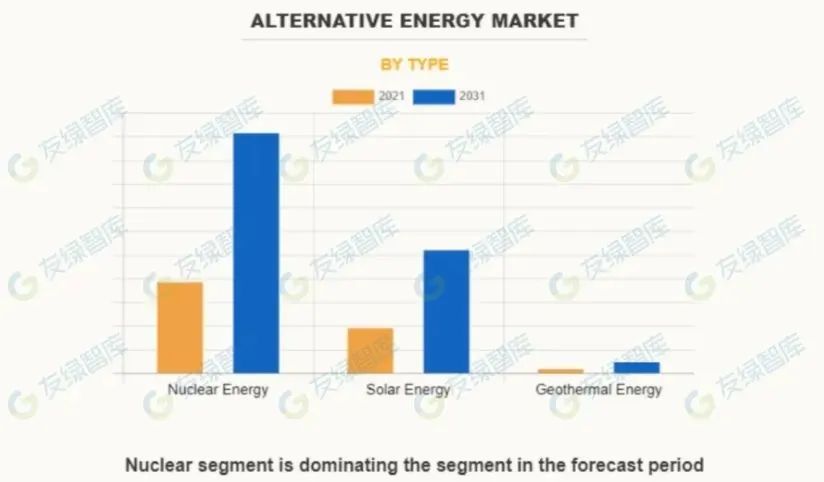
By 2024, utility-scale solar and wind additions will account for nearly 90% of new and expanded projects in the U.S., up from 57% the previous year. This shift highlights the cost advantages and scalability of solar and wind compared to fossil fuels.
Hydropower continues to play a critical role in the renewable energy mix, serving as a baseload power source that provides grid stability and low operating costs.
New hydropower technologies, including advanced turbines, are improving efficiency and adaptability, enabling plants to operate under various hydrological conditions. These upgrades support the integration of hydropower with intermittent renewables like wind and solar.
Additionally, geothermal energy has untapped potential, ranking second only to solar photovoltaics in renewable energy technologies. By 2050, technological advancements could enable geothermal to meet up to 15% of global electricity demand growth.
Next-generation geothermal systems are leveraging advanced drilling techniques to access deeper, hotter resources, expanding global geothermal capacity.
Biomass is expected to contribute to the expansion of renewable fuels, accounting for an estimated 95% of projected growth by 2030. It serves as a transitional solution to replace coal infrastructure and supports bioenergy systems for industrial and grid applications.
Second-generation biofuels produced from non-food biomass provide a sustainable alternative to fossil fuels and reduce greenhouse gas emissions.
Wave and tidal energy technologies are also advancing with improvements in tidal stream generators and wave energy converters. These innovations enhance efficiency and commercial viability, providing diverse renewable energy options, especially in coastal areas.
Causeway Energies manufactures geothermal heat pumps.
The Irish startup Causeway Energies has developed geothermal heating solutions that combine deep geothermal heat pumps, solar thermal storage, and hybrid energy systems. Its deep geothermal heat pumps extract energy from deep underground, providing megawatt-level heat above 120°C to enhance efficiency and reduce reliance on fossil fuels.
GeoSolar systems integrate geothermal and solar energy by storing solar thermal energy underground in summer and recovering it in winter, creating a renewable energy cycle.
This startup’s GeoBattery technology stores waste heat underground in summer to meet seasonal peaks in heating and cooling demand. The Hybrid-GeoX system combines closed-loop and open-loop geothermal methods, performing well in humid but non-aquifer rock formations. These technologies provide sustainable heating and cooling solutions for industrial, commercial, and agricultural sectors.
Rothberger Energy promotes clean hydropower energy production.
The Israeli startup Rothberger Energy designs small, ready-to-use hydropower plants for sites with a waterfall gap of 3 meters or more. Its RBE series includes compact, easy-to-install systems that harness the kinetic energy of falling water to generate clean energy.
This startup’s RBE 400 model operates at heights of 4-8 meters, generating 15-37 kW of power. The RBE 600 operates at 7-17 meters, providing 45-130 kW of power. For lower waterfall gaps of 1.5-3 meters, the RBE 1000 generates 15-45 kW of power, while the RBE 1000+ supports sites at 4-8 meters and generates 50-150 kW of power. Rothberger Energy enables small plants and communities to harness renewable energy, reducing reliance on fossil fuels and achieving energy independence.
6. Green Hydrogen
The green hydrogen market is expected to grow at a CAGR of 61.1%, reaching $30.6 billion by 2030.
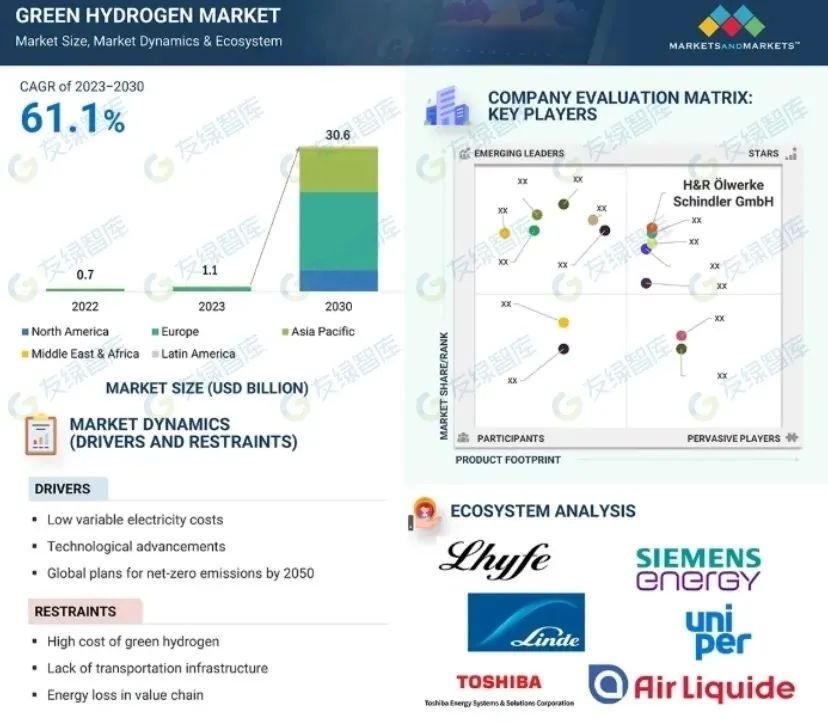
India is working to establish a green hydrogen ecosystem. In the first quarter of 2024, the Solar Energy Corporation of India (SECI) issued a tender to develop 1,500 MW of electrolyzer manufacturing capacity under the Green Hydrogen Transition Strategy (SIGHT) program.
In contrast, Europe faces challenges in green hydrogen deployment. According to the International Energy Agency (IEA) 2023 report, renewable energy capacity dedicated to hydrogen in Europe is expected to be 51% lower than previously estimated, projected to be only 5 GW by 2028.
Green hydrogen production is becoming a key driver for additional renewable energy deployment. As demand for electrolyzers and hydrogen infrastructure grows, it is reshaping power system planning. McKinsey estimates that by 2050, green hydrogen could require about 25% of global renewable electricity generation, equivalent to 14,000 terawatt-hours.
Moreover, electrolyzer technology is advancing to enable cost-effective and scalable green hydrogen production. Proton exchange membrane (PEM) and alkaline electrolyzers can now achieve higher efficiencies and lower operating costs.
Breakthroughs in materials science, such as non-precious metal catalysts replacing expensive platinum group materials, are further reducing production costs.
Additionally, innovations in modular and gigawatt-scale electrolyzer designs are changing the economics of hydrogen production. Modern electrolyzers are designed to scale from megawatt to gigawatt capacities, allowing for flexible deployment to meet regional and industrial needs.
Caplyzer manufactures supercapacitor electrolyzers.
The Swedish startup Caplyzer has developed a patented supercapacitor electrolyzer for industrial hydrogen production. This technology separates the generation of hydrogen and oxygen to prevent gas mixing and maintain high hydrogen purity. It operates without expensive membranes, reducing resistance, lowering costs, and improving efficiency.
It also uses abundant materials on Earth instead of precious metals to promote sustainability and mitigate supply chain challenges. This startup’s electrolyzer’s dynamic response ensures stable performance under variable power inputs, enabling seamless integration with renewables.
SOREN provides SaaS for renewable hydrogen.
The Norwegian startup Soren Hydrogen offers a cloud-based software as a service (SaaS) platform to optimize renewable hydrogen production. The platform includes SOREN LCoH, which guides users through project design by enabling them to determine the scale of renewable energy, electrolyzers, plant balance of plant (BoP), and storage. It also estimates CAPEX, OPEX, NPV, IRR, and levelized cost of hydrogen (LCOH), while conducting sensitivity analysis on key financial metrics to support informed decision-making.
This startup’s SOREN ELY module simplifies project iteration by providing standardized data and connecting users with technology readiness level (TRL) 9 electrolyzers. This includes systems from OEM partners such as AWE, PEM, SOEC, AEM, and MFE. By integrating these tools, the platform can accelerate feasibility assessments and optimize project configurations.
7. IoT Integration
From 2024 to 2030, the IoT market in renewable energy is expected to grow at a CAGR of 7.8%, reaching $113.69 billion.
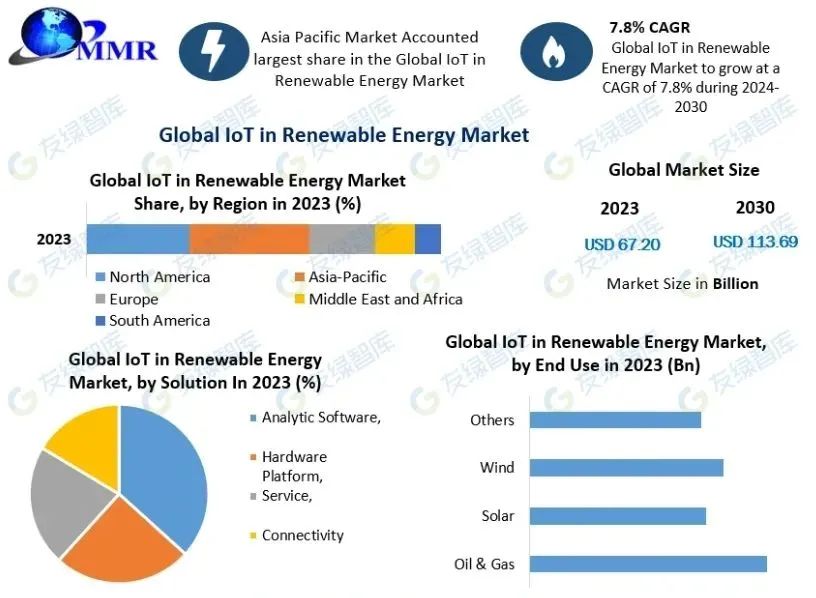
The integration of IoT with renewable energy systems is enhancing grid efficiency, optimizing storage, and enabling real-time performance monitoring.
According to IEA data, by 2025, the share of renewables in global electricity generation will increase from 29% to 35%. This growth is supported by IoT-enabled smart grids and energy management systems.
The expansion of the smart home market is expected to reach $246 billion by 2026, aligning with this trend. IoT connectivity is driving the adoption of residential renewable energy systems like solar panels and battery storage through automated energy optimization.
In Europe, smart energy management is rapidly evolving. By early 2022, 10% of German households had adopted IoT-enabled systems, including smart thermostats, meters, and smart lighting. As IoT solutions become more accessible, this number is expected to rise by 2025.
Additionally, the U.S. is witnessing growth in battery storage, with capacity expected to increase by 14.9 GW to reach 30.9 GW. IoT-enabled smart grid technologies optimize the flow of energy between generation, storage, and consumption points to ensure efficient distribution.
Furthermore, nearly 50% of renewable energy organizations use IoT for performance monitoring, while 45% use it for climate and weather tracking. These data highlight the growing prevalence of interconnected energy management tools.
Real-world examples also demonstrate the impact of IoT on energy efficiency. For instance, the SmartHeat project transformed industrial heat pumps into IoT-connected devices, improving energy efficiency by 4.35%.
Similarly, Tesla’s IoT-connected Powerwall integrates with solar panels to store excess energy and optimize distribution for homes and businesses.
Wazo Smart Systems promotes energy monitoring.
The Kenyan startup Wazo Smart Systems provides real-time energy monitoring solutions using IoT technology. It deploys smart sensors and IoT devices to collect detailed energy usage data, which is then analyzed to identify patterns and trends. This analysis enables customers to reduce energy waste and improve efficiency through informed decision-making.
This startup’s platform features advanced analytics, secure data management, and mobile access, allowing users to monitor energy consumption from anywhere. Wazo Smart Systems transforms traditional buildings into smart infrastructures to support businesses and individuals in achieving energy savings and advancing net-zero carbon goals.
2PM Lab builds marine IoT for tidal energy.
The South Korean startup 2PM Lab has developed marine IoT technology to support sustainable and intelligent marine systems. This technology uses IoT sensors and devices to monitor and manage maritime activities, enhancing offshore efficiency and safety. It includes a flow-induced vibration energy module that harnesses ocean currents to generate renewable energy, reducing reliance on traditional energy sources.
This startup’s marine monitoring system combines real-time data collection with artificial seagrass to track environmental conditions and help protect marine ecosystems. Additionally, its underwater covert platform integrates IoT monitoring and energy supply solutions for defense applications.
8. Microgrids
The global microgrid market is expected to grow at a CAGR of 18.52%, reaching $236.18 billion by 2034 from $51.4 billion in 2025.
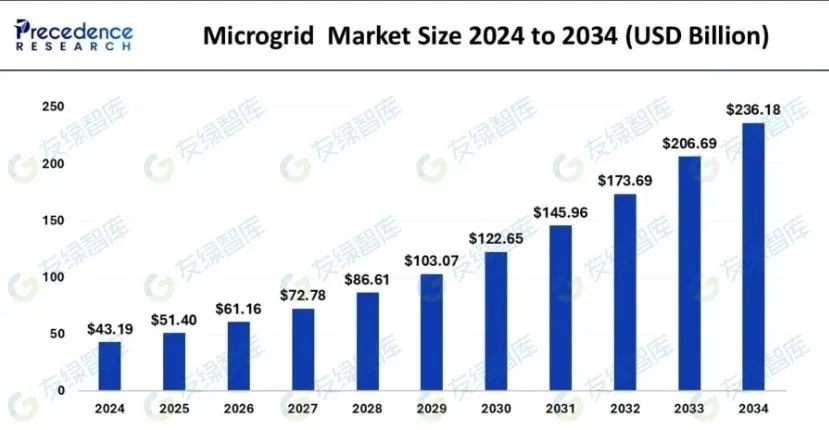
The U.S. Department of Energy’s Loan Programs Office approved a $72.8 million loan guarantee in September 2024 for a solar-plus-storage microgrid on the Viejas Band Indian Reservation in California.
Microgrids provide a platform that combines smart controls with distributed energy resources (DER) such as solar, wind, and battery storage. As microgrids offer a reliable and cost-effective alternative to traditional grid infrastructure, the demand for independent power systems in rural and remote areas is accelerating their adoption.
Latest technological trends in renewable energy, such as blockchain, AI, and IoT, are further enhancing the efficiency of microgrids. By enabling automated control, predictive maintenance, and real-time monitoring, these solutions maximize energy efficiency and grid stability. Additionally, the emergence of energy modeling tools is simplifying microgrid design, allowing developers to select the best energy mix for specific applications.
By incorporating DER into microgrids, distribution is undergoing a significant transformation. Microgrids are shifting from centralized utility structures to a more decentralized, efficient, and resilient power network achieved through on-site generation and targeted energy efficiency.
MicroGrid Solutions builds microgrid systems.
The South African startup MicroGrid Solutions has created microgrid systems that provide reliable power using renewable energy. These systems combine energy inputs from solar, wind, and biomass with storage solutions to create localized energy networks that can operate independently or connect to the main grid.
This startup’s microgrids enhance energy efficiency, reduce operational costs, and ensure uninterrupted power during grid outages to protect critical operations. MicroGrid Solutions promotes energy independence for communities, supports off-grid solutions in remote areas, and facilitates the integration of renewables.
ClimaFi supports microgrid site assessments.
The U.S.-based startup ClimaFi develops microgrid solutions and smart energy management systems that integrate renewables, storage, and smart controls to optimize generation and consumption. Its self-service qualification tool allows businesses to independently assess potential microgrid sites, streamlining the process and focusing on viable development locations.
This startup also offers microgrid designs that include integrating custom EV profiles, tariff modeling, and battery optimization to meet specific site requirements. Additionally, its subscription-based microgrid operations platform uses weather forecasts and machine learning algorithms to predict energy demand and generation.
The platform enhances efficiency by supporting energy arbitrage, purchasing electricity at lower prices, and selling it at higher rates. It also reduces risk by dynamically adjusting energy distribution between building loads and EV charging stations.
9. Blockchain Integration
By 2024, the global energy market blockchain is valued at $3.1 billion, with an expected CAGR of 43.7% from 2025 to 2034. By 2025, it is anticipated that 20% of renewable energy transactions will utilize blockchain technology, highlighting its expanding role in the energy market.
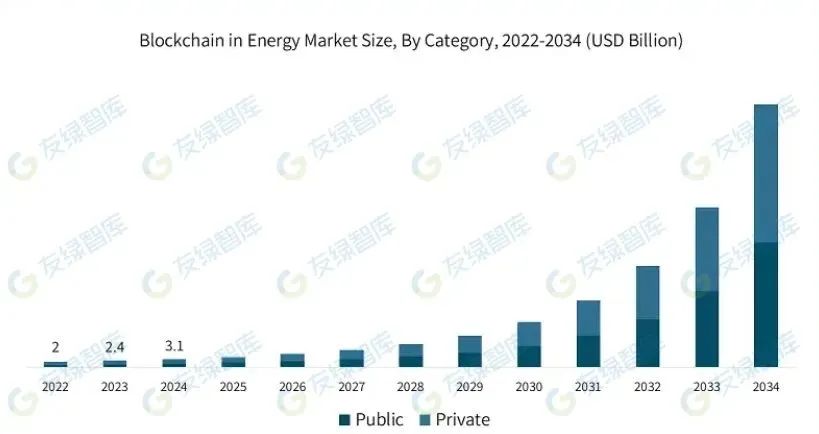
In the past five years, blockchain-based microgrid projects have grown by 300%, demonstrating their ability to support peer-to-peer (P2P) energy exchanges and enhance grid resilience.
Currently, 59% of blockchain energy projects focus on decentralized energy trading. These projects align with peer-to-peer models, allowing consumers to act as both energy producers and consumers simultaneously.
In addition to trading, blockchain is transforming the renewable energy value chain by improving renewable energy certificate (REC) tracking, optimizing grid management, providing transparent supply chain monitoring, and automating contracts.
Moreover, smart contracts enable automated energy trading and ensure compliance. Blockchain-supported systems also enhance the traceability of RECs, providing verifiable proof of renewable energy usage for companies pursuing net-zero goals.
Integrating blockchain with IoT devices can further increase value. Smart meters can now record real-time energy consumption data on the blockchain to improve grid efficiency and enable demand response management.
AI applications also complement blockchain systems. These tools enhance generation forecasting, demand forecasting, and wholesale energy price analysis.
Combining blockchain’s secure record-keeping with AI insights improves efficiency and resource allocation, strengthening operations in the renewable energy market.
Solareum promotes renewable energy certification.
The UAE-based startup Solareum has created SolareumChain, a layer 1 blockchain platform powered by renewable energy. This platform uses a patented proof of generation (PoG) consensus mechanism to verify and record energy production through real-time data from renewable sources.
This process ensures that every unit of energy produced is verifiably green and directly supports blockchain efforts to promote sustainable and transparent energy networks. SolareumChain combines off-chain computing technology to enhance the efficiency of blockchain operations and reduce energy consumption.
FUELHASH supports blockchain-driven solar mining.
The Japanese startup FUELHASH offers FUELSOLAR, a solution that combines renewable energy with cryptocurrency mining. It involves installing solar panels to power mining operations and reduce reliance on traditional energy sources. This startup manages the installation and operation of solar panels and mining equipment.
FUELSOLAR provides instant depreciation, tax incentives, and eligibility for renewable energy subsidies. By combining renewable energy with cryptocurrency mining, FUELHASH creates opportunities to generate digital assets using sustainable energy.
10. Grid Integration
According to forecasts, the global renewable energy smart grid integration market is expected to grow at a CAGR of 9.6% from 2023 to 2031, reaching $427.9 billion by the end of the period.
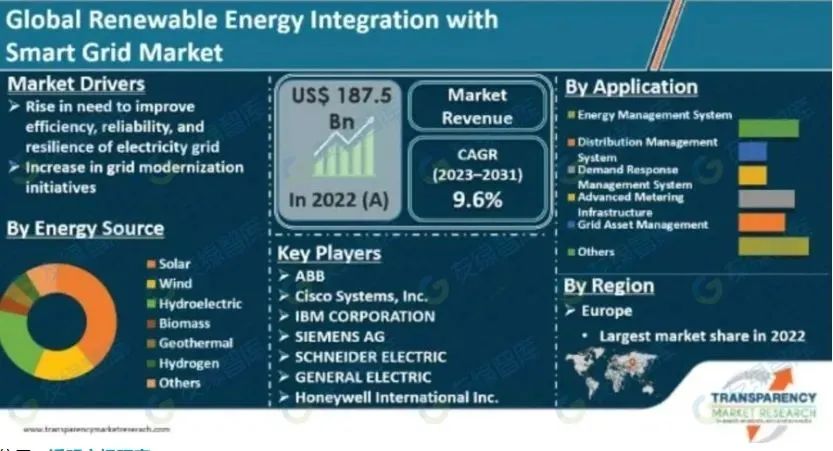
The European Union recognizes that upgrading the grid is crucial to achieving renewable energy goals, as evidenced by its commitment to invest €584 billion by 2030 to support the grid action plan.
The U.S. Department of Energy has allocated $1.5 billion for projects that will add 7.1 GW of installed capacity and approximately 1,000 miles of power lines across multiple states.
As the use of renewable energy increases, maintaining grid stability becomes essential. By 2025, microcontroller-based solutions are expected to improve grid stability by 40% to address voltage and frequency fluctuations caused by intermittent renewable energy generation.
Virtual power plants (VPP) aggregating DERs such as rooftop solar, battery storage, and demand response systems are also gaining popularity. By 2025, the VPP market is expected to grow at a CAGR of 40%, supporting decentralized grid management and flexible energy distribution.
Additionally, advanced grid technologies play a crucial role in integrating renewables. Static synchronous compensators (STATCOM) and static VAR compensators (SVC) maintain voltage levels by providing dynamic reactive power support, enhancing grid stability.
Deploying STATCOMs near solar parks can improve power quality and facilitate the smooth integration of renewables. High-voltage direct current (HVDC) projects also enable long-distance transmission of renewable energy, effectively connecting wind and solar to national and regional grids.
Eluminate optimizes renewable energy grid integration.
The Danish startup Eluminate provides power quality solutions for industrial and commercial clients to optimize electrical systems. It offers active, passive, and hybrid models of REVCON harmonic filters to mitigate electrical harmonics, reduce energy losses, and meet grid standards. These filters stabilize voltage levels and reduce equipment wear, enhancing operational efficiency.
This startup also provides grid connection services to integrate facilities into low, medium, and high-voltage grids. It supports the connection of renewables, including wind farms and solar parks, to ensure efficient integration.
Furthermore, Eluminate implements control and protection systems for substations. These systems include real-time monitoring and comply with IEC standards to enhance grid resilience.
GESI Green Energy Storage Initiative large battery storage systems.
The German startup GESI Green Energy Storage Initiative designs large battery storage systems to stabilize renewable energy supply and improve grid efficiency. These systems charge during periods of excess solar and wind energy to avoid the need to curtail or shut down renewable generation. When output declines, they discharge stored electricity into the grid to reduce reliance on fossil fuels and imported energy.
These batteries act as flexible peaking power plants to balance fluctuations in renewable generation. The GESI battery system, with a 1 GW load and 2 GWh capacity, provides 2 hours of multiple power supplies for approximately 1.8 million households daily. This ensures reliable and cost-effective energy distribution.
This startup focuses on environmentally friendly battery technology using lithium iron phosphate (LFP) batteries. These batteries are free from harmful acids and conflict materials like cobalt. They are certified as non-toxic and safe by the Association for Electrical, Electronic and Information Technologies (VDE), supporting resource efficiency and a circular economy.
Conclusion
Advancements in storage, grid integration, and AI-driven optimization are shaping the future. Emerging trends in renewable energy, such as perovskite solar cells, are enhancing solar efficiency, while floating wind farms are increasing offshore energy potential. Fusion and bioenergy technologies are also becoming complementary clean energy sources. As the adoption of renewable energy grows, integrating these solutions will establish a more resilient, efficient, and sustainable global energy system.
In recent years, China’s renewable energy installed capacity has continuously achieved new breakthroughs, with renewable energy generation steadily increasing. By the end of 2024, the national renewable energy installed capacity will reach 1.889 billion kilowatts, accounting for approximately 56% of the country’s total installed capacity; the national renewable energy generation will reach 3.46 trillion kilowatt-hours, accounting for about 35% of total generation, with wind and solar generation combined being roughly equal to the electricity consumption of the tertiary industry during the same period, far exceeding the electricity consumption of urban and rural residents. Renewable energy is accelerating its transition from a supplementary energy source to a primary energy source, significantly changing the country’s power structure and output.
In 2024, new energy storage in China continues to develop rapidly, with installed capacity exceeding 70 million kilowatts. According to grid companies, the equivalent utilization hours of new energy storage in 2024 are approximately 1,000 hours, playing a key role in promoting the development and consumption of new energy, peak supply assurance, and ensuring the safe and stable operation of the power system, strongly supporting the construction of a new power system.
China is in the industrialization acceleration phase of the top ten trends in renewable energy, with policy drivers (such as the “dual carbon” goals) and technological breakthroughs (such as photovoltaics, energy storage, and ultra-high voltage) forming a global leading advantage. Leading cities are concentrated in the Three North regions (wind and solar resources), the eastern coastal areas (offshore wind, hydrogen), and western energy bases (energy storage, ultra-high voltage).
